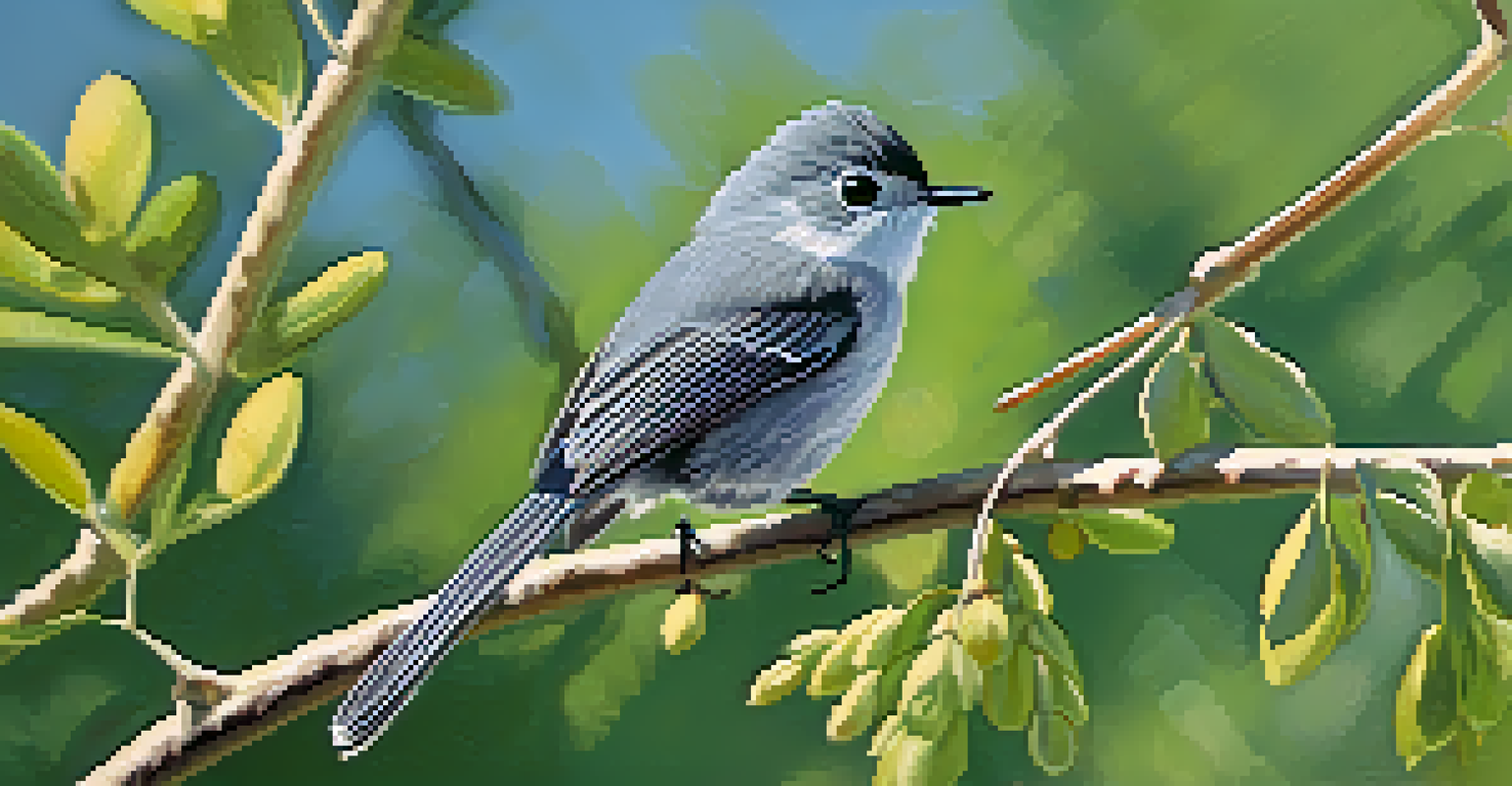Santa Monica Mountains: Home to Diverse Wildlife Species

An Overview of the Santa Monica Mountains Ecosystem
The Santa Monica Mountains are a unique blend of rugged terrain and lush vegetation, stretching from the Pacific Ocean to the San Fernando Valley. This diverse landscape creates a variety of habitats, making it a haven for wildlife. From coastal sage scrub to oak woodlands, each ecosystem supports different species, contributing to the area's rich biodiversity.
In every walk with nature one receives far more than he seeks.
The mountains not only provide a home for wildlife but also serve as a crucial area for ecological studies and conservation efforts. Many organizations work diligently to protect these habitats, ensuring that the delicate balance of life is preserved. This commitment to conservation is vital as urban development continues to encroach on natural spaces.
Visitors to the Santa Monica Mountains can experience the beauty of nature while learning about the various species that inhabit the area. Trails and parks offer opportunities for hiking, birdwatching, and observing wildlife in their natural environment, making it an ideal destination for nature enthusiasts.
The Rich Diversity of Wildlife in the Mountains
The Santa Monica Mountains are home to over 400 species of vertebrates, including mammals, birds, reptiles, and amphibians. This impressive variety showcases the mountains' role as a critical habitat for many animals. Some of the more notable residents include the elusive mountain lion and the endangered California gnatcatcher.

Birdwatchers will find the mountains particularly rewarding, as numerous migratory and resident birds call this area home. From the vibrant red-tailed hawk soaring above to the tiny hummingbirds flitting through the wildflowers, the avian diversity is truly remarkable. This variety not only adds to the ecological richness but also provides a stunning visual experience for visitors.
Biodiversity in Santa Monica Mountains
The Santa Monica Mountains host over 400 species of vertebrates, showcasing their critical role as a diverse habitat.
Reptiles and amphibians also thrive in this environment, with species like the California kingsnake and the Western toad making their homes here. These animals play essential roles in their ecosystems, helping to control insect populations and serving as indicators of environmental health. Their presence highlights the interconnectedness of life within the mountains.
Endangered Species and Conservation Efforts
Among the diverse wildlife, several species found in the Santa Monica Mountains are classified as endangered. The California coastal gnatcatcher and the Southern California steelhead are just a couple of examples that highlight the urgent need for conservation. Protecting these species requires a concerted effort from local communities, conservation groups, and government agencies.
Look deep into nature, and then you will understand everything better.
Efforts to preserve these endangered species include habitat restoration projects, public education initiatives, and wildlife corridors that allow animals to safely navigate between fragmented habitats. These initiatives not only benefit the endangered species but also enhance the overall health of the ecosystem. Community involvement is crucial, as local residents can actively participate in conservation efforts.
Through ongoing conservation work, there is hope for the future of these species and their habitats. Awareness and advocacy play significant roles in ensuring that the Santa Monica Mountains remain a thriving environment for wildlife. By supporting these efforts, we can help safeguard the mountains for generations to come.
The Role of Fire in the Ecosystem
Fire plays a complex role in the Santa Monica Mountains ecosystem, acting as both a destructive force and a natural rejuvenator. While wildfires can devastate areas, they also promote new growth, helping to maintain the health of certain plant species. Many native plants have evolved to thrive in post-fire conditions, showcasing the resilience of this environment.
The cycle of fire and regeneration is crucial for many species, including the iconic chaparral plants that dominate the landscape. After a fire, these plants can flourish, providing food and shelter for wildlife. This natural process emphasizes the importance of understanding and respecting the role of fire in maintaining ecological balance.
Conservation Efforts Are Crucial
Endangered species like the California gnatcatcher highlight the urgent need for community involvement in conservation initiatives.
However, with climate change and increased urban development, the frequency and intensity of wildfires are changing. This makes it essential to implement fire management strategies that protect both human communities and wildlife. By acknowledging the dual nature of fire, we can better prepare for its inevitable occurrence while supporting the recovery of the ecosystem.
Hiking Trails: A Gateway to Wildlife Observation
One of the best ways to experience the diverse wildlife of the Santa Monica Mountains is through its extensive network of hiking trails. These trails range from easy strolls to challenging hikes, catering to all levels of outdoor enthusiasts. As you walk along the paths, you’ll often spot wildlife, whether it's a deer grazing in a meadow or a fox darting through the underbrush.
The trails also provide opportunities to engage with the natural environment and learn about the plants and animals that inhabit the mountains. Many trails are equipped with informational signs that educate hikers about local wildlife, their habitats, and conservation efforts. This educational component enhances the hiking experience, making it both enjoyable and informative.
Moreover, hiking in these mountains offers a unique chance to connect with nature and escape the hustle and bustle of city life. Whether you're looking for a peaceful retreat or an adventure in the wild, the Santa Monica Mountains provide the perfect backdrop for exploration and wildlife observation.
The Impact of Urban Development on Wildlife
As Los Angeles continues to grow, the Santa Monica Mountains face increasing pressure from urban development. Roads, housing, and commercial projects can fragment habitats, making it challenging for wildlife to thrive. This encroachment can lead to conflicts between humans and animals, as wildlife seeks food and shelter in suburban areas.
The impact of urbanization extends beyond habitat loss; it also affects the ecological dynamics of the region. Increased pollution, noise, and human activity can disrupt animal behaviors and reduce their populations. Understanding these effects is critical for developing effective conservation strategies and promoting coexistence between wildlife and urban communities.
Urban Development Threatens Wildlife
As urbanization increases, habitat fragmentation poses significant challenges for wildlife, necessitating wildlife-friendly urban planning.
To mitigate these challenges, local agencies are implementing wildlife-friendly practices in urban planning. Creating wildlife corridors, preserving open spaces, and promoting community awareness are essential steps toward balancing development with conservation. By fostering a sense of stewardship, we can help ensure that the Santa Monica Mountains continue to support diverse wildlife for years to come.
How You Can Help Protect the Santa Monica Mountains
Everyone can play a role in protecting the Santa Monica Mountains and its wildlife, even if you’re not a conservation expert. Simple actions like staying on designated trails, respecting wildlife, and not littering can make a significant difference. By being mindful of our impact on the environment, we can help preserve these beautiful mountains for future generations.
Volunteering with local conservation organizations is another impactful way to contribute. Whether it’s participating in clean-up events, habitat restoration projects, or educational outreach, your involvement can help foster a healthier ecosystem. Engaging with your community and raising awareness about the importance of wildlife conservation can inspire others to take action as well.

Lastly, supporting policies and initiatives aimed at protecting natural habitats is crucial. Educating yourself and others about the challenges facing the Santa Monica Mountains can lead to informed discussions and advocacy. Together, we can create a collective effort to ensure that these mountains remain a sanctuary for diverse wildlife and a cherished resource for all.